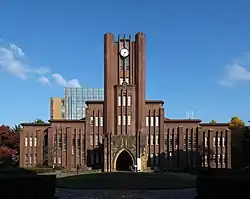| Yasuda Auditorium | |
|---|---|
安田講堂 東京大学大講堂 | |
 Yasuda Auditorium as seen from the front | |
| Alternative names | Yasuda Hall |
| General information | |
| Architectural style | Gothic revival |
| Town or city | Hongō, Bunkyō-ku, Tokyo, Japan |
| Coordinates | 35°42′47.999″N 139°45′42.999″E / 35.71333306°N 139.76194417°E |
| Named for | Yasuda Zenjiro |
| Opened | 1925 |
| Affiliation | University of Tokyo |
| Technical details | |
| Floor count | 8 |
| Floor area | 6,990 square meters |
| Design and construction | |
| Architect(s) | Yoshikazu Uchida, Hideto Kishida |
| Main contractor | Shimizu Corporation |
Yasuda Auditorium (安田講堂, Yasuda kōdō) is a building and clock tower at the center of the Hongō campus of the University of Tokyo. It serves as the central symbol of the campus,[1] where special events and graduation ceremonies are held.[2]
History
The building was completed in 1925 with a donation from businessman Yasuda Zenjirō, who intended for the building to be a binden (a place the Emperor of Japan could stay). The building was designed by architects Yoshikazu Uchida[3] and Hideto Kishida, the latter of whom was an expressionist.[4] During the Second World War, in October 1940, the auditorium was the site of a special celebration of the anniversaries of the Imperial Rescript on Education and of the establishment of the Imperial Family of Japan in power.[2]
During the 1968-69 Japanese university protests, the building was occupied by student demonstrators - first in June 1968, when a dispute at the University of Tokyo Medical School led to medical students occupying the building and then being expelled from it soon after by riot police, and again starting in summer, when students barricaded themselves inside the building. Over the weekend of 18–19 January 1969, the protestors were cleared out of the building by riot police.[5] After the protests, the Yasuda zaibatsu helped renovate the building.[3] Since the protests, the building has never been used to commemorate entrance or graduation ceremonies, but it has become a symbol of the University of Tokyo.[6]
Architecture
The architecture of Yasuda Auditorium has been compared to that of the University of Cambridge's gate tower, which Uchida could have been inspired by. To the university, the building represents the modernization efforts of the University of Tokyo. The red-brick used in the building is indicative of the architecture in the period following the Great Kantō Earthquake of 1923.[3] The building's architecture is part of the Gothic Revival school, a school of architecture new to Japan by the time the building was built. The prominence of the clock tower over the circular building has been described as "phallic".[7]
The building includes an auditorium, central administrative offices for the university, and a room made specifically for the Emperor where he would wait to give special watches to all graduates.[1]
References
Citations
- 1 2 Steinhoff 2013, p. 142.
- 1 2 Devine & Summerfield 2013, p. 649.
- 1 2 3 The University of Tokyo.
- ↑ Kohte, Adam & Hubert 2017, p. 213.
- ↑ Steinhoff 2013, pp. 142–45.
- ↑ Steinhoff 2013, pp. 149–50.
- ↑ Adriasola 2015, p. 113.
General bibliography
- Adriasola, Ignacio (1 January 2015). "Modernity and Its Doubles: Uncanny Spaces of Postwar Japan". October (151): 108–127. doi:10.1162/OCTO_a_00205. Retrieved 14 July 2021.
- Devine, Mary Elizabeth; Summerfield, Carol (2 December 2013). International Dictionary of University Histories. Taylor & Francis. ISBN 978-1-134-26217-5.
- "Yasuda Auditorium". The University of Tokyo. Retrieved 14 July 2021.
- Kohte, Susanne; Adam, Hubertus; Hubert, Daniel (20 March 2017). Encounters and Positions: Architecture in Japan. Birkhäuser. ISBN 978-3-0356-0715-4.
- Steinhoff, Patricia G. (2013). "Memories of New Left protest". Contemporary Japan. 25 (2): 127–165. doi:10.1515/cj-2013-0007. Retrieved 14 July 2021.